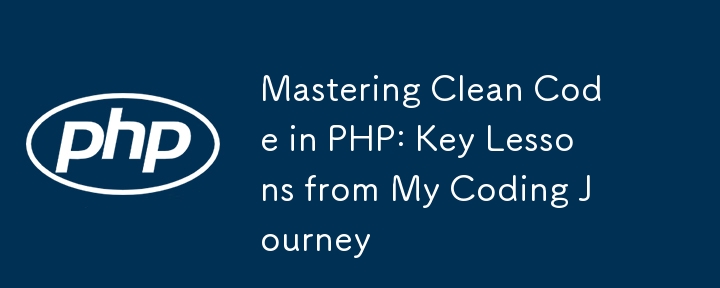掌握 PHP 中的簡潔程式碼:我的程式設計之旅的主要經驗教訓

「掌握PHP 中的乾淨程式碼:我的編碼之旅的重要經驗教訓」重點介紹實用的實踐規則和範例,以幫助PHP 開發人員編寫乾淨、可維護且高效率的代碼。在這裡,我們將把這些基本規則分解為易於理解的部分,每個部分都附有一個範例。
1. 有意義的名字
- 規則:為變數、函數和類別使用清晰且描述性的名稱。
- 為什麼:這使您的程式碼更易於理解和維護。
範例:
// BAD:
$x = 25;
function d($a, $b) {
return $a + $b;
}
// GOOD:
$age = 25;
function calculateSum($firstNumber, $secondNumber) {
return $firstNumber + $secondNumber;
}
描述:
- 避免使用單字母變量,例如 $x 或 $d。相反,請使用描述性名稱,例如 $age 或calculateSum。
- 清晰的名稱使您的意圖明確,幫助當前和未來的開發人員理解程式碼的用途。
2. 單一責任原則(SRP)
- 規則:一個函數或類別應該只有一個改變的理由,這意味著它應該只做一件事。
- 為什麼:這使您的程式碼更加模組化並且更容易重構。
範例:
// BAD:
class Order {
public function calculateTotal() {
// logic to calculate total
}
public function sendInvoiceEmail() {
// logic to send email
}
}
// GOOD:
class Order {
public function calculateTotal() {
// logic to calculate total
}
}
class InvoiceMailer {
public function sendInvoiceEmail() {
// logic to send email
}
}
描述:
- 在 BAD 範例中,Order 類別負責計算總數並發送電子郵件。這違反了 SRP,因為它有兩個責任。
- 在GOOD範例中,我們透過建立負責電子郵件任務的 InvoiceMailer 類別來分離關注點,使每個類別更易於管理和更新。
3. 保持函數較小
- 規則:函數應該做一件事並且做好它。將大函數分解為更小的函數。
- 為什麼:小函數比較容易理解、測試和維護。
範例:
// BAD:
function processOrder($order) {
// Validate order
if (!$this->validateOrder($order)) {
return false;
}
// Calculate total
$total = $this->calculateTotal($order);
// Send invoice
$this->sendInvoiceEmail($order);
return true;
}
// GOOD:
function processOrder($order) {
if (!$this->isOrderValid($order)) {
return false;
}
$this->finalizeOrder($order);
return true;
}
private function isOrderValid($order) {
return $this->validateOrder($order);
}
private function finalizeOrder($order) {
$total = $this->calculateTotal($order);
$this->sendInvoiceEmail($order);
}
描述:
- 在 BAD 範例中,processOrder 函數嘗試執行所有操作:驗證、計算和發送發票。
- 在 GOOD 範例中,我們將任務分解為更小、更集中的方法(isOrderValid、finalizeOrder),從而提高了可讀性和可重用性。
4. 避免使用幻數和字串
- 規則:用命名常數取代「神奇」數字和字串。
- 為什麼:這提高了可讀性並使程式碼更容易修改。
範例:
// BAD:
if ($user->age > 18) {
echo "Eligible";
}
// GOOD:
define('MINIMUM_AGE', 18);
if ($user->age > MINIMUM_AGE) {
echo "Eligible";
}
描述:
- 在 BAD 範例中,數字 18 是一個「神奇數字」。在分析上下文之前,你不知道它代表什麼。
- 在 GOOD 範例中,使用 MINIMUM_AGE 使意圖變得清晰,並允許您在一個位置更改值而無需搜尋程式碼庫。
5. DRY(不要重複自己)
- 規則:避免重複程式碼。盡可能重複使用函數或類別。
- 為什麼:重複的程式碼更難維護並且更容易出現錯誤。
範例:
// BAD:
$total = $itemPrice * $quantity;
$finalPrice = $total - ($total * $discountRate);
$cartTotal = $cartItemPrice * $cartQuantity;
$finalCartPrice = $cartTotal - ($cartTotal * $cartDiscountRate);
// GOOD:
function calculateFinalPrice($price, $quantity, $discountRate) {
$total = $price * $quantity;
return $total - ($total * $discountRate);
}
$finalPrice = calculateFinalPrice($itemPrice, $quantity, $discountRate);
$finalCartPrice = calculateFinalPrice($cartItemPrice, $cartQuantity, $cartDiscountRate);
描述:
- 在BAD範例中,價格計算邏輯是重複的。
- 在GOOD範例中,我們建立了一個可重複使用的函數calculateFinalPrice以避免重複並使程式碼更易於維護。
6. 使用保護子句來減少巢狀
- 規則:不使用深層嵌套的if語句,而是提前返回以簡化結構。
- 為什麼:保護子句消除了不必要的嵌套,使程式碼更乾淨、更易於遵循。
範例:
// BAD:
function processPayment($amount) {
if ($amount > 0) {
if ($this->isPaymentMethodAvailable()) {
if ($this->isUserLoggedIn()) {
// Process payment
}
}
}
}
// GOOD:
function processPayment($amount) {
if ($amount <= 0) {
return;
}
if (!$this->isPaymentMethodAvailable()) {
return;
}
if (!$this->isUserLoggedIn()) {
return;
}
// Process payment
}
描述:
- 在BAD範例中,邏輯巢狀很深,導致閱讀更加困難。
- 在GOOD範例中,保護子句用於在不滿足條件時提前返回,從而扁平化結構並使程式碼更清晰。
7. 評論“為什麼”,而不是“什麼”
- 規則:寫註解來解釋為什麼會發生某些事情,而不是解釋正在發生的事情(這應該從程式碼中清楚地看出)。
- 為什麼:註解應該提供超越顯而易見的價值,有助於解釋程式碼背後的意圖和推理。
範例:
// BAD: // Increment age by 1 $age++; // GOOD: // User's birthday has passed, increase age by 1 $age++;
描述:
- The BAD comment simply restates what the code does, which is obvious from the code itself.
- The GOOD comment explains why we are incrementing the age, adding meaningful context.
8. Refactor for Clarity
- Rule: Continuously refactor to improve code clarity and simplicity.
- Why: Clean code is achieved through constant refactoring to ensure that it is always readable, efficient, and maintainable.
Example:
// Before Refactoring:
function getDiscountedPrice($price, $isHoliday) {
if ($isHoliday) {
return $price * 0.9;
} else {
return $price;
}
}
// After Refactoring:
function getDiscountedPrice($price, $isHoliday) {
return $isHoliday ? $price * 0.9 : $price;
}
Description:
- Refactoring transforms long-winded code into more concise, elegant versions without losing clarity. In this example, we simplified an if-else structure using a ternary operator.
These essential rules—derived from the journey of coding cleanly in PHP—make your code more readable, maintainable, and scalable. By applying these principles consistently, you ensure that your code is easy to understand and modify over time, regardless of the complexity of your projects.
以上是掌握 PHP 中的簡潔程式碼:我的程式設計之旅的主要經驗教訓的詳細內容。更多資訊請關注PHP中文網其他相關文章!

熱AI工具

Undresser.AI Undress
人工智慧驅動的應用程序,用於創建逼真的裸體照片

AI Clothes Remover
用於從照片中去除衣服的線上人工智慧工具。

Undress AI Tool
免費脫衣圖片

Clothoff.io
AI脫衣器

Video Face Swap
使用我們完全免費的人工智慧換臉工具,輕鬆在任何影片中換臉!

熱門文章

熱工具

記事本++7.3.1
好用且免費的程式碼編輯器

SublimeText3漢化版
中文版,非常好用

禪工作室 13.0.1
強大的PHP整合開發環境

Dreamweaver CS6
視覺化網頁開發工具

SublimeText3 Mac版
神級程式碼編輯軟體(SublimeText3)
 在PHP API中說明JSON Web令牌(JWT)及其用例。
Apr 05, 2025 am 12:04 AM
在PHP API中說明JSON Web令牌(JWT)及其用例。
Apr 05, 2025 am 12:04 AM
JWT是一種基於JSON的開放標準,用於在各方之間安全地傳輸信息,主要用於身份驗證和信息交換。 1.JWT由Header、Payload和Signature三部分組成。 2.JWT的工作原理包括生成JWT、驗證JWT和解析Payload三個步驟。 3.在PHP中使用JWT進行身份驗證時,可以生成和驗證JWT,並在高級用法中包含用戶角色和權限信息。 4.常見錯誤包括簽名驗證失敗、令牌過期和Payload過大,調試技巧包括使用調試工具和日誌記錄。 5.性能優化和最佳實踐包括使用合適的簽名算法、合理設置有效期、
 PHP 8.1中的枚舉(枚舉)是什麼?
Apr 03, 2025 am 12:05 AM
PHP 8.1中的枚舉(枚舉)是什麼?
Apr 03, 2025 am 12:05 AM
PHP8.1中的枚舉功能通過定義命名常量增強了代碼的清晰度和類型安全性。 1)枚舉可以是整數、字符串或對象,提高了代碼可讀性和類型安全性。 2)枚舉基於類,支持面向對象特性,如遍歷和反射。 3)枚舉可用於比較和賦值,確保類型安全。 4)枚舉支持添加方法,實現複雜邏輯。 5)嚴格類型檢查和錯誤處理可避免常見錯誤。 6)枚舉減少魔法值,提升可維護性,但需注意性能優化。
 會話如何劫持工作,如何在PHP中減輕它?
Apr 06, 2025 am 12:02 AM
會話如何劫持工作,如何在PHP中減輕它?
Apr 06, 2025 am 12:02 AM
會話劫持可以通過以下步驟實現:1.獲取會話ID,2.使用會話ID,3.保持會話活躍。在PHP中防範會話劫持的方法包括:1.使用session_regenerate_id()函數重新生成會話ID,2.通過數據庫存儲會話數據,3.確保所有會話數據通過HTTPS傳輸。
 描述紮實的原則及其如何應用於PHP的開發。
Apr 03, 2025 am 12:04 AM
描述紮實的原則及其如何應用於PHP的開發。
Apr 03, 2025 am 12:04 AM
SOLID原則在PHP開發中的應用包括:1.單一職責原則(SRP):每個類只負責一個功能。 2.開閉原則(OCP):通過擴展而非修改實現變化。 3.里氏替換原則(LSP):子類可替換基類而不影響程序正確性。 4.接口隔離原則(ISP):使用細粒度接口避免依賴不使用的方法。 5.依賴倒置原則(DIP):高低層次模塊都依賴於抽象,通過依賴注入實現。
 解釋PHP中的晚期靜態綁定(靜態::)。
Apr 03, 2025 am 12:04 AM
解釋PHP中的晚期靜態綁定(靜態::)。
Apr 03, 2025 am 12:04 AM
靜態綁定(static::)在PHP中實現晚期靜態綁定(LSB),允許在靜態上下文中引用調用類而非定義類。 1)解析過程在運行時進行,2)在繼承關係中向上查找調用類,3)可能帶來性能開銷。
 什麼是REST API設計原理?
Apr 04, 2025 am 12:01 AM
什麼是REST API設計原理?
Apr 04, 2025 am 12:01 AM
RESTAPI設計原則包括資源定義、URI設計、HTTP方法使用、狀態碼使用、版本控制和HATEOAS。 1.資源應使用名詞表示並保持層次結構。 2.HTTP方法應符合其語義,如GET用於獲取資源。 3.狀態碼應正確使用,如404表示資源不存在。 4.版本控制可通過URI或頭部實現。 5.HATEOAS通過響應中的鏈接引導客戶端操作。
 您如何在PHP中有效處理異常(嘗試,捕捉,最後,投擲)?
Apr 05, 2025 am 12:03 AM
您如何在PHP中有效處理異常(嘗試,捕捉,最後,投擲)?
Apr 05, 2025 am 12:03 AM
在PHP中,異常處理通過try,catch,finally,和throw關鍵字實現。 1)try塊包圍可能拋出異常的代碼;2)catch塊處理異常;3)finally塊確保代碼始終執行;4)throw用於手動拋出異常。這些機制幫助提升代碼的健壯性和可維護性。
 PHP中的匿名類是什麼?您何時可以使用它們?
Apr 04, 2025 am 12:02 AM
PHP中的匿名類是什麼?您何時可以使用它們?
Apr 04, 2025 am 12:02 AM
匿名類在PHP中的主要作用是創建一次性使用的對象。 1.匿名類允許在代碼中直接定義沒有名字的類,適用於臨時需求。 2.它們可以繼承類或實現接口,增加靈活性。 3.使用時需注意性能和代碼可讀性,避免重複定義相同的匿名類。






